Earlier This Semester, I Got This Book Out For A Class On The Material Culture Of Christianity. It’s



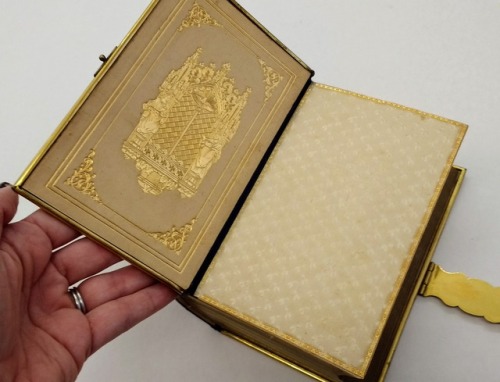

Earlier this semester, I got this book out for a class on the material culture of Christianity. It’s a beautiful Bible bound in purple velvet, with gold embellishments, edges, and clasps. It originally came in a leather case lined with silk, which has since fallen to pieces at the joints, but the same silk features on the gilded endpapers. The clasp is even engraved with the initials of the book’s first owner, Josephine Bonaparte Bolton.
This book is beautiful, but it’s even more interesting after reading the note that came with it from its donor, Josephine’s granddaughter:
When Josephine Bonaparte Bolton was sixteen years old, she taught three negro women to read and write. Her mother, Mrs. Wm. Bolton, was so proud of her daughter’s achievement, that she gave her this little Bible as a memento. The Boltons lived in Jefferson City, Missouri.
Josephine Bolton Kerns (Granddaughter)
June 1, 1977
The clasp is dated 1851, which means that the original Josephine broke Missouri law by giving reading and writing lessons to the three African American women mentioned in the note. Missouri law in 1847 stated that “No person shall keep or teach any school for the instruction of negroes or mulattos, in reading or writing, in this State.” Teaching a person of color to read was punishable by a fine of not less than $500 and up to six months in jail.
I could not find any information about either Josephine, but for the most part, the Bolton families of Cole County and Jefferson City seem to have been Confederate sympathizers. Dr. William Bolton, who may have been Josephine’s father, was a prominent Jefferson City physician and a known slave owner. I’d love to know more about Josephine, her mother, and the story behind this beautiful book. Wouldn’t you?
- Kelli
The Holy Bible, containing the Old and New Testaments : translated out of the original tongues, and with the former translations diligently compared and revised, by His Majesty’s special command, appointed to be read in churches. London : Eyre and Spottiswoode, 1848. Rare BS185 1848 .L6
More Posts from Philosophical-amoeba and Others



Breakthrough on ash dieback
UK scientists have identified the country’s first ash tree that shows tolerance to ash dieback.
Ash dieback is spreading throughout the UK and in one woodland in Norfolk, a great number of trees are infected.
The team compared the genetics of trees with different levels of tolerance to ash dieback disease. From there, they developed three genetic markers which enabled them to predict whether or not a tree is likely to be tolerant to the disease. One tree named Betty, they discovered, was predicted to show strong tolerance.
The findings raise the possibility of using selective breeding to develop strains of trees that are tolerant to the disease to help safeguard our forests.
Read more
Images: Close-up infected ash petioles (leaf stems) - Copyright: John Innes Centre
Can the brain feel it? The world’s smallest extracellular needle-electrodes
A research team in the Department of Electrical and Electronic Information Engineering and the Electronics-Inspired Interdisciplinary Research Institute (EIIRIS) at Toyohashi University of Technology developed 5-μm-diameter needle-electrodes on 1 mm × 1 mm block modules. This tiny needle may help solve the mysteries of the brain and facilitate the development of a brain-machine interface. The research results were reported in Scientific Reports on Oct 25, 2016.

(Image caption: Extracellular needle-electrode with a diameter of 5 μm mounted on a connector)
The neuron networks in the human brain are extremely complex. Microfabricated silicon needle-electrode devices were expected to be an innovation that would be able to record and analyze the electrical activities of the microscale neuronal circuits in the brain.
However, smaller needle technologies (e.g., needle diameter < 10 μm) are necessary to reduce damage to brain tissue. In addition to the needle geometry, the device substrate should be minimized not only to reduce the total amount of damage to tissue but also to enhance the accessibility of the electrode in the brain. Thus, these electrode technologies will realize new experimental neurophysiological concepts.
A research team in the Department of Electrical and Electronic Information Engineering and the EIIRIS at Toyohashi University of Technology developed 5- μm-diameter needle-electrodes on 1 mm × 1 mm block modules.
The individual microneedles are fabricated on the block modules, which are small enough to use in the narrow spaces present in brain tissue; as demonstrated in the recording using mouse cerebrum cortices. In addition, the block module remarkably improves the design variability in the packaging, offering numerous in vivo recording applications.
“We demonstrated the high design variability in the packaging of our electrode device, and in vivo neuronal recordings were performed by simply placing the device on a mouse’s brain. We were very surprised that high quality signals of a single unit were stably recorded over a long period using the 5-μm-diameter needle,” explained the first author, Assistant Professor Hirohito Sawahata, and co-author, researcher Shota Yamagiwa.
The leader of the research team, Associate Professor Takeshi Kawano said: “Our silicon needle technology offers low invasive neuronal recordings and provides novel methodologies for electrophysiology; therefore, it has the potential to enhance experimental neuroscience.” He added, “We expect the development of applications to solve the mysteries of the brain and the development of brain–machine interfaces.”
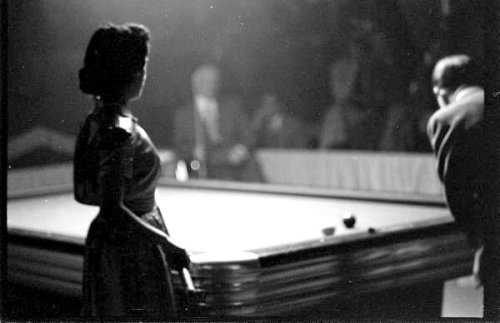
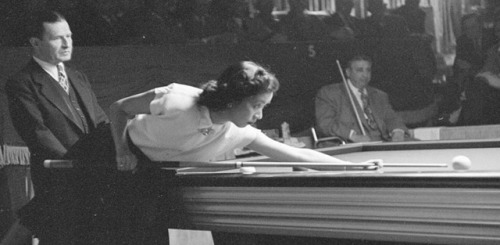
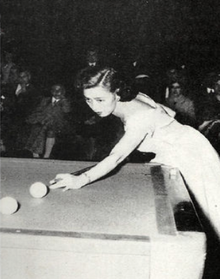

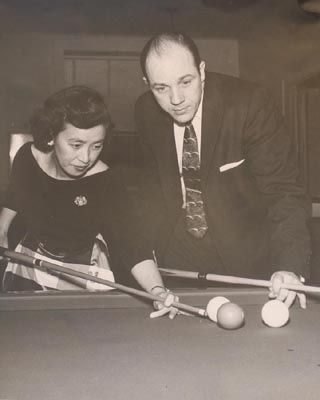
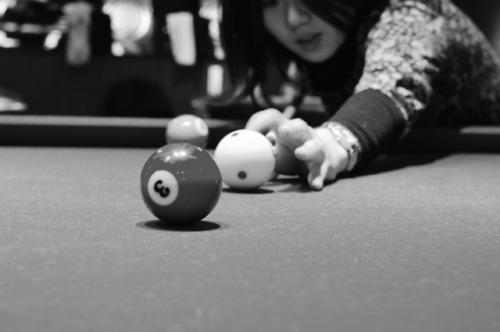
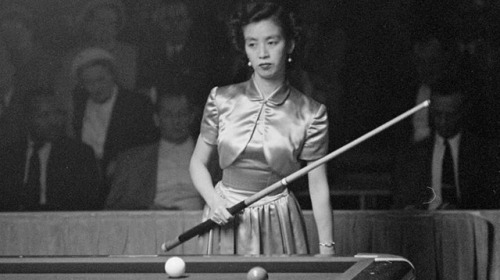
“Men want to beat me. I play men, six, seven hours a day. Men… they do not beat me.”
- Masako “Katsy” Katsura, first woman to compete for a world’s title in billiards
The “First Lady of Billiards” learned from her brother-in-law and in the 50s became Japan’s only female billiards pro. She paved the way for women to come, then left the spotlight and lived a quiet life. She died in 1995.
I am 100% convinced that “exit, pursued by a bear” is a reference to some popular 1590s meme that we’ll never be able to understand because that one play is the only surviving example of it.
Sasando
pic: wikipedia

The sasando is a harp-like musical instrument from East Nusa Tenggara, Indonesia, specifically in the island of Rote. The name is derived from the Rote dialect word “sasandu” meaning “vibrating or sounded instrument.” It can have 28 or 56 strings.
There’s a folktale that explained the origins of the sasando. Once, there was a boy called Sangguana who lived in Rote. One day, he was tired and fell asleep under a palmyra tree, and dreamt that he played beautiful music with a unique instrument that made an enchanting sound. When he woke up, Sangguana was able to vividly remember the melody he played in the dream. He wanted to hear it once more, so he slept again, and dreamt of the same song and the same instrument. Sangguana had to wake up, eventually, but, not wanting to lose the instrument from his dream, he made an instrument out of palmyra leaves based on the one he saw in his dream, which became the basis for the sasando.
if you want to see how it sounds: (start 0:30)


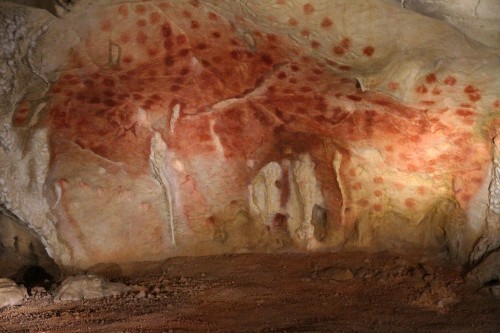


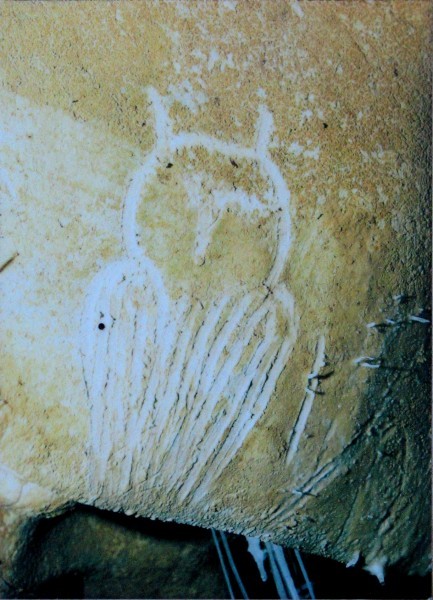
CHAUVET CAVE:
THE Chauvet Cave (also known as the Chauvet-Pont-d’Arc Cave) is a Palaeolithic cave situated near Vallon-Pont-d’Arc in the Ardèche region of southern France that houses impeccably preserved, exquisite examples of prehistoric art.
Now reliably dated to between c. 33,000 and c. 30,000 years ago, the numerous and diverse animals that dot the interior walls of the cave – both painted and engraved – show such high artistic quality that they were initially thought to have been closer in age to the similarly stunning, but much younger art in caves such as the Lascaux Cave. Its age and artistry have made us reconsider the story of art as well as the capabilities of these humans. The cave has been granted UNESCO World Heritage status.
Read More
Article by Emma Groeneveld on AHE




Quick Study of the Maiko’s Furisode Kimono+Undergarments!
Just a simple little vocabulary dump! Still learning the details (there are many!) and would love any corrections or elaborations to be made!

Hadajuban: The first layer underneath a Maiko’s kimono. It is said that Geiko and Maiko don’t wear underwear because it throws off the line of the kimono; instead, they wear multi-layer undergarments.
Nagajuban: Another garment with sleeves, made of cotton, that goes over the Hadajuban.
Koshihimo: An under-wrap belt that holds the undergarments together in a foundation shape for the kimono over it.
Korin belt: Ties the juban collars together.
Obi-Ita: Stiff padding that will help to hold the obi belt in place.
Obi-Makura: “Pillow” that ties around from the front. This supports the front of the obi belt. I’ve read it’s something only girls wearing kimono use.
Eri Shin: Long strand of cardboard or plastic that serves as a collar stiffener.
Tabi: White, sometimes buttoned up, socks that separate the big toe from the rest of the four toes. Worn along with a Maiko’s Okobo or Zori.

Furisode Kimono: Formal-looking kimono with a characteristic of long, billowy sleeves with the seam connecting the top sleeve to the hanging sleeve visible. This kimono is also a popular formal traditional kimono for unmarried women. Originally, furisode kimono were only worn by children (both boys and girls) from well-off or even wealthy families. This connects the tradition of the Maiko symbolizing “childhood” and “youthfulness”.
Maru Obi: Primarily used by Maiko (or traditional brides), these especially formal obi belts are heavy, rich with brocade embroidery and very long. Both sides are usually fully patterned; a Maiko wears her obi tied in the back, one end of the belt folded slightly over the other, cascading in a loose-look down to her ankles.
Obi-jime: A thin braid of stippled silk that wraps around the front of the obi and holds it together with a final touch. The obi clasps are expensive and beautiful bejeweled and are attached to the obi-jime to adorn the front of the kimono.
Please message me if you’d like to add an ingredient to this list! I work with google and the books I have for accurate and complete information, and sometimes I just can’t find all that I’m lookin’ for! Thanks!
( @gion-lady )

The U.S. space agency launched a new web-based search engine for much of its catalog of images, video and audio files, which you can browse by keyword and metadata, so that you never have to remember the dismal reality that you’re earthbound ever again.

Man with quadriplegia employs injury bridging technologies to move again—just by thinking
First recipient of implanted brain-recording and muscle-stimulating systems reanimates limb that had been stilled for eight years
Bill Kochevar grabbed a mug of water, drew it to his lips and drank through the straw.
His motions were slow and deliberate, but then Kochevar hadn’t moved his right arm or hand for eight years.
And it took some practice to reach and grasp just by thinking about it.
Kochevar, who was paralyzed below his shoulders in a bicycling accident, is believed to be the first person with quadriplegia in the world to have arm and hand movements restored with the help of two temporarily implanted technologies.
A brain-computer interface with recording electrodes under his skull, and a functional electrical stimulation (FES) system* activating his arm and hand, reconnect his brain to paralyzed muscles.
Holding a makeshift handle pierced through a dry sponge, Kochevar scratched the side of his nose with the sponge. He scooped forkfuls of mashed potatoes from a bowl—perhaps his top goal—and savored each mouthful.
“For somebody who’s been injured eight years and couldn’t move, being able to move just that little bit is awesome to me,” said Kochevar, 56, of Cleveland. “It’s better than I thought it would be.”
Kochevar is the focal point of research led by Case Western Reserve University, the Cleveland Functional Electrical Stimulation (FES) Center at the Louis Stokes Cleveland VA Medical Center and University Hospitals Cleveland Medical Center (UH). A study of the work was published in the The Lancet March 28 at 6:30 p.m. U.S. Eastern time.
“He’s really breaking ground for the spinal cord injury community,” said Bob Kirsch, chair of Case Western Reserve’s Department of Biomedical Engineering, executive director of the FES Center and principal investigator (PI) and senior author of the research. “This is a major step toward restoring some independence.”
When asked, people with quadriplegia say their first priority is to scratch an itch, feed themselves or perform other simple functions with their arm and hand, instead of relying on caregivers.
“By taking the brain signals generated when Bill attempts to move, and using them to control the stimulation of his arm and hand, he was able to perform personal functions that were important to him,” said Bolu Ajiboye, assistant professor of biomedical engineering and lead study author.
Technology and training
The research with Kochevar is part of the ongoing BrainGate2* pilot clinical trial being conducted by a consortium of academic and VA institutions assessing the safety and feasibility of the implanted brain-computer interface (BCI) system in people with paralysis. Other investigational BrainGate research has shown that people with paralysis can control a cursor on a computer screen or a robotic arm (braingate.org).
“Every day, most of us take for granted that when we will to move, we can move any part of our body with precision and control in multiple directions and those with traumatic spinal cord injury or any other form of paralysis cannot,” said Benjamin Walter, associate professor of neurology at Case Western Reserve School of Medicine, clinical PI of the Cleveland BrainGate2 trial and medical director of the Deep Brain Stimulation Program at UH Cleveland Medical Center.
“The ultimate hope of any of these individuals is to restore this function,” Walter said. “By restoring the communication of the will to move from the brain directly to the body this work will hopefully begin to restore the hope of millions of paralyzed individuals that someday they will be able to move freely again.”
Jonathan Miller, assistant professor of neurosurgery at Case Western Reserve School of Medicine and director of the Functional and Restorative Neurosurgery Center at UH, led a team of surgeons who implanted two 96-channel electrode arrays—each about the size of a baby aspirin—in Kochevar’s motor cortex, on the surface of the brain.
The arrays record brain signals created when Kochevar imagines movement of his own arm and hand. The brain-computer interface extracts information from the brain signals about what movements he intends to make, then passes the information to command the electrical stimulation system.
To prepare him to use his arm again, Kochevar first learned how to use his brain signals to move a virtual-reality arm on a computer screen.
“He was able to do it within a few minutes,” Kirsch said. “The code was still in his brain.”
As Kochevar’s ability to move the virtual arm improved through four months of training, the researchers believed he would be capable of controlling his own arm and hand.
Miller then led a team that implanted the FES systems’ 36 electrodes that animate muscles in the upper and lower arm.
The BCI decodes the recorded brain signals into the intended movement command, which is then converted by the FES system into patterns of electrical pulses.
The pulses sent through the FES electrodes trigger the muscles controlling Kochevar’s hand, wrist, arm, elbow and shoulder. To overcome gravity that would otherwise prevent him from raising his arm and reaching, Kochevar uses a mobile arm support, which is also under his brain’s control.
New Capabilities
Eight years of muscle atrophy required rehabilitation. The researchers exercised Kochevar’s arm and hand with cyclical electrical stimulation patterns. Over 45 weeks, his strength, range of motion and endurance improved. As he practiced movements, the researchers adjusted stimulation patterns to further his abilities.
Kochevar can make each joint in his right arm move individually. Or, just by thinking about a task such as feeding himself or getting a drink, the muscles are activated in a coordinated fashion.
When asked to describe how he commanded the arm movements, Kochevar told investigators, “I’m making it move without having to really concentrate hard at it…I just think ‘out’…and it goes.”
Kocehvar is fitted with temporarily implanted FES technology that has a track record of reliable use in people. The BCI and FES system together represent early feasibility that gives the research team insights into the potential future benefit of the combined system.
Advances needed to make the combined technology usable outside of a lab are not far from reality, the researchers say. Work is underway to make the brain implant wireless, and the investigators are improving decoding and stimulation patterns needed to make movements more precise. Fully implantable FES systems have already been developed and are also being tested in separate clinical research.
Kochevar welcomes new technology—even if it requires more surgery—that will enable him to move better. “This won’t replace caregivers,” he said. “But, in the long term, people will be able, in a limited way, to do more for themselves.”
The investigational BrainGate technology was initially developed in the Brown University laboratory of John Donoghue, now the founding director of the Wyss Center for Bio and Neuroengineering in Geneva, Switzerland. The implanted recording electrodes are known as the Utah array, originally designed by Richard Normann, Emeritus Distinguished Professor of Bioengineering at the University of Utah.
The report in Lancet is the result of a long-running collaboration between Kirsch, Ajiboye and the multi-institutional BrainGate consortium. Leigh Hochberg, a neurologist and neuroengineer at Massachusetts General Hospital, Brown University and the VA RR&D Center for Neurorestoration and Neurotechnology in Providence, Rhode Island, directs the pilot clinical trial of the BrainGate system and is a study co-author.
“It’s been so inspiring to watch Mr. Kochevar move his own arm and hand just by thinking about it,” Hochberg said. “As an extraordinary participant in this research, he’s teaching us how to design a new generation of neurotechnologies that we all hope will one day restore mobility and independence for people with paralysis.”
Why do we love?

Ah, romantic love; beautiful and intoxicating, heart-breaking and soul-crushing… often all at the same time! Why do we choose to put ourselves though its emotional wringer? Does love make our lives meaningful, or is it an escape from our loneliness and suffering? Is love a disguise for our sexual desire, or a trick of biology to make us procreate? Is it all we need? Do we need it at all?
If romantic love has a purpose, neither science nor psychology has discovered it yet – but over the course of history, some of our most respected philosophers have put forward some intriguing theories.

1. Love makes us whole, again / Plato (427—347 BCE)
The ancient Greek philosopher Plato explored the idea that we love in order to become complete. In his Symposium, he wrote about a dinner party at which Aristophanes, a comic playwright, regales the guests with the following story. Humans were once creatures with four arms, four legs, and two faces. One day they angered the gods, and Zeus sliced them all in two. Since then, every person has been missing half of him or herself. Love is the longing to find a soul mate who will make us feel whole again… or at least that’s what Plato believed a drunken comedian would say at a party.


2. Love tricks us into having babies / Schopenhauer (1788-1860)
Much, much later, German philosopher Arthur Schopenhauer maintained that love, based in sexual desire, was a “voluptuous illusion”. He suggested that we love because our desires lead us to believe that another person will make us happy, but we are sorely mistaken. Nature is tricking us into procreating and the loving fusion we seek is consummated in our children. When our sexual desires are satisfied, we are thrown back into our tormented existences, and we succeed only in maintaining the species and perpetuating the cycle of human drudgery. Sounds like somebody needs a hug.


3. Love is escape from our loneliness / Russell (1872-1970)
According to the Nobel Prize-winning British philosopher Bertrand Russell we love in order to quench our physical and psychological desires. Humans are designed to procreate; but, without the ecstasy of passionate love, sex is unsatisfying. Our fear of the cold, cruel world tempts us to build hard shells to protect and isolate ourselves. Love’s delight, intimacy, and warmth helps us overcome our fear of the world, escape our lonely shells, and engage more abundantly in life. Love enriches our whole being, making it the best thing in life.


4. Love is a misleading affliction / Buddha (~6th- 4thC BCE)
Siddhartha Gautama. who became known as ‘the Buddha’, or ‘the enlightened one’, probably would have had some interesting arguments with Russell. Buddha proposed that we love because we are trying to satisfy our base desires. Yet, our passionate cravings are defects, and attachments – even romantic love – are a great source of suffering. Luckily, Buddha discovered the eight-fold path, a sort of program for extinguishing the fires of desire so that we can reach ‘nirvana’ – an enlightened state of peace, clarity, wisdom, and compassion.


5. Love lets us reach beyond ourselves / Beauvoir (1908-86)
Let’s end on a slightly more positive note. The French philosopher Simone de Beauvoir proposed that love is the desire to integrate with another and that it infuses our lives with meaning. However, she was less concerned with why we love and more interested in how we can love better. She saw that the problem with traditional romantic love is it can be so captivating that we are tempted to make it our only reason for being. Yet, dependence on another to justify our existence easily leads to boredom and power games.

To avoid this trap, Beauvoir advised loving authentically, which is more like a great friendship: lovers support each other in discovering themselves, reaching beyond themselves, and enriching their lives and the world, together.


Though we might never know why we fall in love, we can be certain that it’ll be an emotional rollercoaster ride. It’s scary and exhilarating. It makes us suffer and makes us soar. Maybe we lose ourselves. Maybe we find ourselves. It might be heartbreaking or it might just be the best thing in life. Will you dare to find out?
From the TED-Ed Lesson Why do we love? A philosophical inquiry - Skye C. Cleary
Animation by Avi Ofer
-
 hdslibrary liked this · 7 years ago
hdslibrary liked this · 7 years ago -
 philosophical-amoeba reblogged this · 7 years ago
philosophical-amoeba reblogged this · 7 years ago -
 noo-im-not-addicted-to-books reblogged this · 7 years ago
noo-im-not-addicted-to-books reblogged this · 7 years ago -
 the-hollows-are-my-home reblogged this · 7 years ago
the-hollows-are-my-home reblogged this · 7 years ago -
 operahousebookworm reblogged this · 7 years ago
operahousebookworm reblogged this · 7 years ago -
 jealousoftheirjudgment reblogged this · 7 years ago
jealousoftheirjudgment reblogged this · 7 years ago -
 bibliobeque reblogged this · 7 years ago
bibliobeque reblogged this · 7 years ago -
 darthfluff liked this · 8 years ago
darthfluff liked this · 8 years ago -
 lianabrooks reblogged this · 8 years ago
lianabrooks reblogged this · 8 years ago -
 lyingsaint reblogged this · 8 years ago
lyingsaint reblogged this · 8 years ago -
 flayrah reblogged this · 8 years ago
flayrah reblogged this · 8 years ago -
 delphinidin4 reblogged this · 8 years ago
delphinidin4 reblogged this · 8 years ago -
 leviathanwithwhiskers reblogged this · 8 years ago
leviathanwithwhiskers reblogged this · 8 years ago -
 leviathanwithwhiskers liked this · 8 years ago
leviathanwithwhiskers liked this · 8 years ago -
 fidaltrout liked this · 8 years ago
fidaltrout liked this · 8 years ago -
 eclipsedmoon liked this · 8 years ago
eclipsedmoon liked this · 8 years ago -
 fluffywinged liked this · 8 years ago
fluffywinged liked this · 8 years ago -
 crackmonkeytrash liked this · 8 years ago
crackmonkeytrash liked this · 8 years ago -
 essie-essex reblogged this · 8 years ago
essie-essex reblogged this · 8 years ago -
 essie-essex liked this · 8 years ago
essie-essex liked this · 8 years ago -
 maeglinthebold reblogged this · 8 years ago
maeglinthebold reblogged this · 8 years ago -
 nephastearchive liked this · 8 years ago
nephastearchive liked this · 8 years ago -
 muhammad-ubaidullah-khan liked this · 8 years ago
muhammad-ubaidullah-khan liked this · 8 years ago -
 marandreetti-blog-blog liked this · 8 years ago
marandreetti-blog-blog liked this · 8 years ago -
 booksandteasplease reblogged this · 8 years ago
booksandteasplease reblogged this · 8 years ago -
 booksandteasplease liked this · 8 years ago
booksandteasplease liked this · 8 years ago -
 rowanlane reblogged this · 8 years ago
rowanlane reblogged this · 8 years ago -
 tadeujose liked this · 8 years ago
tadeujose liked this · 8 years ago -
 ieda99 liked this · 8 years ago
ieda99 liked this · 8 years ago -
 displacedmermaid reblogged this · 8 years ago
displacedmermaid reblogged this · 8 years ago -
 displacedmermaid liked this · 8 years ago
displacedmermaid liked this · 8 years ago -
 authorrachelgraves liked this · 8 years ago
authorrachelgraves liked this · 8 years ago -
 dare-mightythings liked this · 8 years ago
dare-mightythings liked this · 8 years ago -
 esckeyes reblogged this · 8 years ago
esckeyes reblogged this · 8 years ago -
 justlookingfornow-thanks liked this · 8 years ago
justlookingfornow-thanks liked this · 8 years ago -
 forgetful-amoeba liked this · 8 years ago
forgetful-amoeba liked this · 8 years ago -
 saratogahistoryroom liked this · 8 years ago
saratogahistoryroom liked this · 8 years ago -
 oldbookdoc reblogged this · 8 years ago
oldbookdoc reblogged this · 8 years ago -
 jomacmouse liked this · 8 years ago
jomacmouse liked this · 8 years ago -
 me-lunitari liked this · 8 years ago
me-lunitari liked this · 8 years ago -
 azaylea liked this · 8 years ago
azaylea liked this · 8 years ago -
 saardestaartje liked this · 8 years ago
saardestaartje liked this · 8 years ago -
 theegoist liked this · 8 years ago
theegoist liked this · 8 years ago -
 thelittlescrimshaw liked this · 8 years ago
thelittlescrimshaw liked this · 8 years ago -
 habibisstarcrown liked this · 8 years ago
habibisstarcrown liked this · 8 years ago -
 wordwelder reblogged this · 8 years ago
wordwelder reblogged this · 8 years ago
A reblog of nerdy and quirky stuff that pique my interest.
291 posts